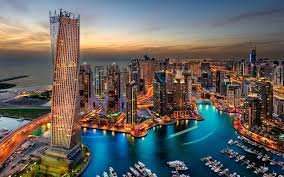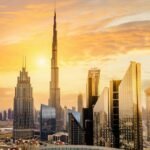Now Reading: Dubai Real Estate: 7 Investor Cities Offering Low Tax and High Yield
-
01
Dubai Real Estate: 7 Investor Cities Offering Low Tax and High Yield
Dubai Real Estate: 7 Investor Cities Offering Low Tax and High Yield

Table of Contents
Dubai’s real estate market continues to attract U.S. investors with its tax-free environment, high rental yields, and investor-friendly policies. With no personal income tax, capital gains tax, or annual property taxes, investors retain 100% of rental income and resale profits, unlike in the U.S., where federal and state taxes can reduce returns by 15-30%.
The UAE dirham’s peg to the U.S. dollar ensures currency stability, and the Golden Visa program, offering 10-year residency for investments of AED 2 million ($545,000), enhances appeal. In 2025, Dubai’s market is thriving, with Q1 transaction values reaching AED 110 billion and a 19.9% year-on-year price increase, per Dubai Land Department data.
This article highlights seven investor-friendly communities in Dubai, offering low tax burdens and high rental yields (6-10%), ideal for U.S. investors seeking strong returns.
1. Downtown Dubai: Luxury and High Demand
Downtown Dubai, home to the Burj Khalifa and Dubai Mall, is a premium hub for high-net-worth investors. Apartments here yield 5.5-7.2%, with studios starting at AED 1.5 million ($408,000). The absence of income and capital gains taxes maximizes returns, while high occupancy rates (over 90%) driven by tourists and executives ensure steady income.
Off-plan projects, like Emaar’s Burj Al Arab Views, offer 6-7% annual appreciation potential. The area’s proximity to business and cultural landmarks boosts demand. U.S. investors must report rental income on IRS Schedule E, but deductions like depreciation can offset taxes.
2. Dubai Marina: Waterfront Profitability
Dubai Marina, known for its canal views and vibrant lifestyle, offers rental yields of 6-6.5% for luxury apartments starting at AED 1.2 million ($326,000). The tax-free environment ensures full retention of rental income, compared to U.S. markets where taxes erode profits.
High demand from expats and tourists, fueled by Dubai’s 25 million projected visitors in 2025, supports occupancy rates above 90%. The area’s proximity to yacht clubs and dining enhances tenant appeal. Off-plan investments provide flexible payment plans and 7-8% appreciation by completion. Verify developer credentials to avoid delays.
3. Jumeirah Village Circle (JVC): Affordable High Yields
Jumeirah Village Circle (JVC) is an emerging hotspot offering affordable apartments starting at AED 550,000 ($150,000) with yields of 7-8%. Its tax-free status allows investors to retain all rental income, far surpassing U.S. yields (2-4% in cities like New York). JVC’s family-friendly amenities, including schools and parks, attract expats, ensuring high demand.
The area’s 7% price growth in 2024 signals strong capital appreciation. Off-plan projects offer lower entry costs but carry delay risks, so choose developers like Nakheel. U.S. investors can deduct maintenance and depreciation to reduce IRS tax liability.
4. Business Bay: Commercial and Residential Hub
Business Bay, Dubai’s central business district, offers residential yields of 5-6% and commercial yields of 6-7% for properties starting at AED 750,000 ($204,000). The absence of property and capital gains taxes maximizes net returns, unlike New York, where property taxes alone can reach 10-20%.
Its proximity to Downtown Dubai and DIFC drives demand from professionals, with occupancy rates near 90%. Off-plan commercial units offer higher ROI but require market expertise. U.S. investors should report foreign accounts over $10,000 via FBAR. Diversify across residential and commercial to mitigate oversupply risks.
5. Dubai South: Emerging Growth Zone
Dubai South, near Al Maktoum International Airport and Expo City, offers studios starting at AED 480,000 ($130,000) with yields up to 8.1%. The tax-free environment and zero-rated VAT on first residential sales reduce costs, unlike U.S. markets with high transaction taxes.
Proximity to the world’s largest airport (post-expansion) and Expo legacy zones drives rental demand. Off-plan projects like Emaar South’s Urbana provide 7-10% appreciation potential by 2026. Construction delays are a risk, so verify escrow compliance with the Dubai Land Department.
6. Palm Jumeirah: Ultra-Luxury Returns
Palm Jumeirah, a global symbol of luxury, offers apartments and villas starting at AED 2 million ($545,000) with yields of 6-7.6%. Its tax-free rental income and capital gains make it a standout, compared to London’s 15% stamp duties or U.S. capital gains taxes.
High demand from affluent tenants and tourists ensures occupancy rates above 85%. Off-plan projects like Palm Jumeirah’s Sea Mirror offer early-bird pricing and 8% appreciation potential. U.S. investors can qualify for the Golden Visa, reducing management costs. Due diligence on developers is critical to avoid delays.
7. Dubai Creek Harbour: Future-Proof Investment
Dubai Creek Harbour, with its waterfront lifestyle and smart city features, offers apartments starting at AED 1.3 million ($354,000) with yields of 6-7%. The tax-free environment and zero VAT on first sales enhance affordability, unlike U.S. markets with high property taxes.
Its proximity to Ras Al Khor Wildlife Sanctuary and future Creek Tower drives tenant demand. Off-plan projects like Creek Crescent, set for 2027 completion, offer 8-10% appreciation. U.S. investors should monitor oversupply risks and use RERA-registered agents. Report assets via IRS Form 8938 if over $50,000.
U.S. Tax Compliance and Benefits
Dubai’s tax-free status—no income, capital gains, or property taxes offers superior returns compared to U.S. cities like New York (3-5% yields) or London (2-4%). A $1 million property yielding 7% generates $70,000 tax-free annually in Dubai, versus $50,000-$60,000 after taxes in the U.S. However, U.S. investors must report rental income on Schedule E, deducting expenses like depreciation ($36,364 annually for a $1 million property), maintenance, and management fees.
Foreign assets over $50,000 (single filers) or $100,000 (joint filers) require Form 8938, and accounts exceeding $10,000 need an FBAR. Non-compliance risks penalties up to $100,000. The 4% DLD transfer fee isn’t creditable against U.S. taxes. Consult a tax professional to maximize deductions.
Risks and Mitigation Strategies
Dubai’s market is robust, with AED 306.3 billion in 2024 transactions and a projected 5-9% price increase in 2025. However, risks include off-plan delays, potential oversupply in JVC or Business Bay, and global economic factors like oil price volatility. Mitigate by choosing reputable developers (Emaar, Damac), verifying escrow compliance with DLD, and diversifying across property types and locations. Work with RERA-registered agents to ensure transparency.
Why Invest in Dubai in 2025?
Dubai’s Economic Agenda D33, targeting a doubled economy by 2033, and 25 million projected tourists in 2025 drive rental demand. High yields (6-10%), zero taxes, and Golden Visa benefits outpace global hubs like New York or London. Communities like Downtown Dubai, Dubai Marina, and Dubai South offer diverse opportunities, from luxury to affordable investments. With strategic planning and IRS compliance, U.S. investors can achieve superior ROI in these seven high-yield, low-tax cities.
In conclusion, Downtown Dubai, Dubai Marina, JVC, Business Bay, Dubai South, Palm Jumeirah, and Dubai Creek Harbour stand out for their high yields, tax-free returns, and growth potential. By leveraging Dubai’s investor-friendly policies and mitigating risks, U.S. investors can build wealth in one of the world’s most dynamic real estate markets in 2025. investor
read more: Dubai Property Market: 7 Tax-Friendly Strategies for Smarter 2025 Investments






















